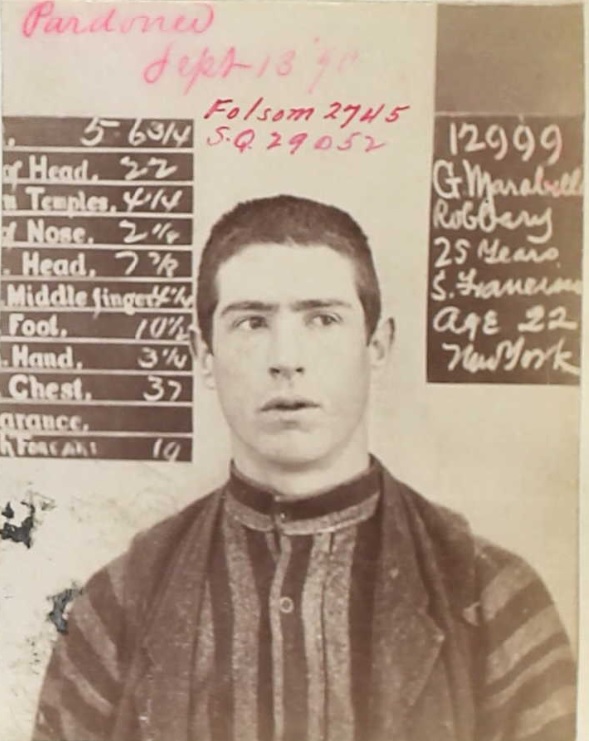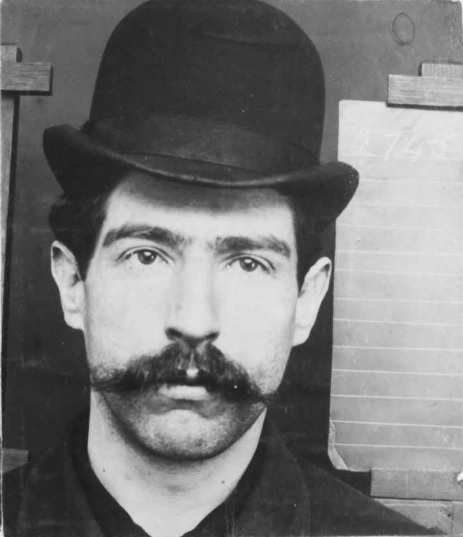Moore’s choices led to San Quentin, Folsom prisons
In 1938, three-time convicted felon George Moore sat for his identification photo at Folsom State Prison. According to prison records, he was 73 years old, serving a term for “sex perversion.”
His photos show a man who bears the scars of a lifetime of poor choices, most of it spent behind bars. His 1938 prison record simply reads “nose removed.”
In this installment, Inside CDCR goes behind the photo to tell the cautionary tale of George Moore.
Moore was man of many names and faces


Moore had many aliases throughout his criminal career. In newspapers and prison records, he’s also listed as George Marabella, George Bailey, and George Foy.
His earliest state prison record goes back to 1884 as a 19-year-old sentenced out of Stanislaus County to a year in state prison for burglary.
In 1887, as a 22-year-old, he and a friend jumped a San Francisco saloonkeeper, cleaning out the cash register of $30. In modern terms, that is the equivalent of about $900.
“Two very tough hoodlums were convicted of robbery,” newspapers reported at the time. “On September 7, they entered the saloon of John Meyer, on Polk Street near Sutter, and beat him brutally, after which they robbed him.”
The judge gave each of them a sentence of one to 25 years at Folsom State Prison.
In 1888, he was transferred to San Quentin. Due to good behavior, he was pardoned in 1890 and released.
Crimes escalate in severity
Shortly after midnight in San Francisco in 1892, Moore and Robert Bennett dragged a woman into Lafayette Square. According to news reports, the men posed as police officers, telling the woman she was under arrest for public intoxication.
Meanwhile, real police officers patrolling the area heard screams and found the victim struggling with her captors.
“One of the ruffians proved to be George Marabella (Moore), a convict who was released by Governor Markham on condition that he leave the state,” reported the Evening Mail, May 3, 1892.
Moore was sentenced to Folsom State Prison for 20 years after his rape conviction.
George Moore photo shows ravages of drug addiction


Moore was released Jan. 23, 1905, but found himself in trouble again. In 1915, using the last name Foy, he was caught breaking into the Visalia office of Dr. S.C. Page. Moore and accomplice George Wright were sentenced to one year at San Quentin.
They were arrested by Tulare County Sheriff Court Smith, who later became warden at Folsom State Prison.
“Both men are victims of the drug habit,” reported the Tulare County Times, Nov. 25, 1915.
The District Attorney’s Office recommended “the prisoners to the clemency of the court.”
The judge said he “was very sorry indeed to have to impose penitentiary sentences.”
Wright confessed to the crime, saying they had run out of opium. He also thanked Smith, the courts and the district attorney.
“I am glad I got a sentence that will keep me away from the dope long enough to break away for good,” he said.
Moore entered a guilty plea to receiving stolen property. He would only say he looked forward to seeing “all the gang” at San Quentin. He was discharged in 1916.
Moore continues spiral
Just three years later, Moore was again in trouble, this time for robbing a drug store in Marysville. He and accomplice Frank Brown were caught in the act at 2:30 a.m. by night watchman William Burke.
“Both men confessed to (police) they were drug fiends and that they came here from Sacramento,” reported the Sacramento Daily Union, Aug. 24, 1919. “Both men are almost ill for want of the drug.”
On Sept. 18, 1938, the 73-year-old Moore was sent to Folsom State Prison from San Diego County for “sex perversion” with a 1-to-15-year sentence. In the 1940 census, he is listed as incarcerated in Folsom Prison.
No more information could be found on what became of Moore.
Nose prosthetics at the turn of the 20th century
Prosthetic noses were available in the early 1900s. According to the San Francisco Call, “the making of artificial noses has reached a high state of perfection.”
“Should (a nose) be lost by accident or disease, a very good substitute can be purchased,” the newspaper reported, Dec. 31, 1904.
The best were made from wax, costing $185. A lower-cost version could be had for $75. These were still very expensive at the time so an enamel-sealed paper-mache nose was the best value at $5.
By Don Chaddock, Inside CDCR editor
Related content:
- In 1891, Frederick Beck landed in San Quentin.
- Henry Herrill began working as a guard in 1891.
- California correctional officers train in former seminary.
